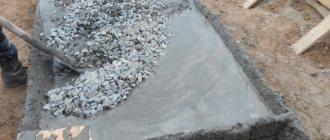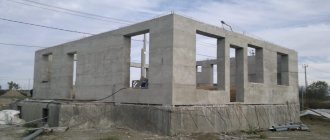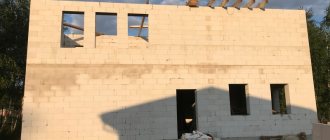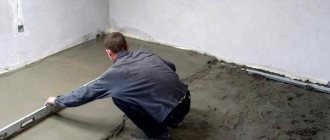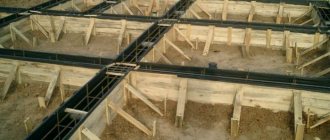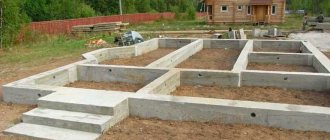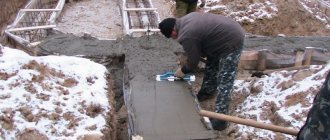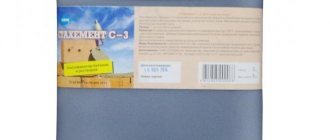The sand-gravel mixture is on a par with other types of basic fillers (crushed stone, gravel, construction waste, slag) intended for the production of heavy concrete.
The fundamental difference is that for the production of Gost concrete, Gost fillers and Gost sand are used, and for the production of heavy concrete approximately corresponding to GOST, a mixture of coarse and fine aggregates is used in the form of a sand-gravel mixture “PGS”.
At the same time, concrete made from ASG has its own individual advantages - it is an accessible and relatively inexpensive material that performs its functions, all other things being equal.
How much to measure in buckets
Sand and gravel mixtures (abbreviated as SGS) are a finished product consisting of coarse and fine aggregate. Moreover, gravel accounts for up to 75% of the total volume. But this figure belongs to the category of mixtures called enriched. There is also a natural class of PGS, in which the ratio of components can vary within very wide limits. This material is released to consumers directly from the quarry, without additional processing. Mixtures are used:
- as part of concrete for pouring foundations;
- when installing drainage in road construction;
- as a leveling layer for landscaping.
It is possible to obtain good quality concrete from PGS only by using enriched raw materials without clay impurities and with a gravel content of 65-75%. The lower the percentage of gravel in the mixture, the lower the strength characteristics of the material.
Selection of materials
Having decided to develop the site, you should purchase all the building materials that may be needed for the work. You need to purchase sand-crushed stone mixture exclusively from time-tested manufacturers.
It is worth knowing that when making concrete from PGS, the proportions of gravel and sand in the mixture may differ. For example, the classic PGS (unenriched) contains only 20 percent gravel, while the enriched one contains 75 percent of the material.
Typically, experts advise using an enriched composition, in which crushed stone predominates. Components for the production of PGS, which are mined from the bottom of a river or sea, have high quality characteristics, so it is recommended to add them to prepare the mixture. River and sea components (gravel and sand) contain virtually no impurities, which increases the adhesion of the mixture to other elements of concrete. As a result, the master is guaranteed to receive high-quality PGS concrete for the foundation, the proportions of which will fully comply with the standards.
Calculation of concrete mixture composition
The classification of concrete is based on compressive strength. In accordance with the requirements of SNiP2.03.01-84 “Concrete and reinforced concrete structures”, the marking of concrete on concrete structures, as well as from a mixture of sand and crushed stone, contains the letter “B” and numbers indicating the load in MPa. This is a relatively new designation.
The more familiar marking with the letter “M” and strength, measured in kg/cm 2, has not lost its relevance. By the way, cement is marked in exactly the same way. Concrete grades from M100 to M 500 are used in construction.
The strength, density and other characteristics of the final product are affected by the ratio of cement and the proportion of PGS in concrete, as well as the content of aggregates made from grains of different sizes in the mixture. The following grades of concrete are used for certain purposes:
- M 150 – it is recommended to prepare for the construction of foundations for light buildings of one floor;
- M 200 – used in the construction of strip and low-power slab foundations;
- M 250 – for foundations in the form of a monolithic slab for medium loads;
- M 300 – for monolithic foundations of any design;
- M 400 - with high-quality cement, used for the construction of especially powerful foundations under heavy loads.
To improve the adhesion of the components of the concrete mixture to each other, it is recommended to use cement containing calcium silicates up to 80%.
For the convenience of calculating material consumption, we will combine the proportions of pgs and cement for concrete of different grades into a table.
According to the table, you can understand that from 10 liters of M400 cement you can get 41 liters of M 300 concrete. If you measure proportions in buckets, then to prepare concrete you need to measure out one bucket of cement and almost 7 buckets of sand and gravel mixture.
Using the available proportions, you can easily calculate the need for materials to prepare 1 m 3 of concrete. Let's make simple equations:
- You will need M400 cement: 1000 * 10:41 = 244 liters or 24.5 buckets.
- ASG for 1 cubic meter of concrete should be taken: 1000 * 49:41 = 1195 liters or 119.5 buckets.
For water, the calculated amount may differ from the actual amount depending on the moisture content of the dry composition and its ability to absorb water. Therefore, during kneading, you do not need to use the entire volume at once. Water should be added in small portions until the solution reaches the desired consistency.
How to dilute cement with sand
Beginner developers who do not have practical experience in carrying out construction activities encounter problems when trying to dilute cement. The composition turns out to be too thick or, conversely, very fluid. And after hardening, it cracks and does not gain the required strength. Despite the apparent simplicity of the task, not everyone knows how to dilute M500 cement, as well as other brands of Portland cement. Let's start with the basics.
How to properly dilute cement with sand when preparing a cement-sand mortar? Builders often use the following methods for diluting Portland cement:
- The first method involves pouring water into a mixing container, followed by adding sand and cement. The ingredients of the sand-cement mixture are thoroughly mixed with the addition, if necessary, of a small amount of water;
- the second method is based on a different principle. First, the bulk components of the mixture - Portland cement and sand - are poured into the container. Then they are mixed evenly. The prepared cement-sand mixture is diluted with water to a plastic state.
Not everyone knows how to dilute cement during the preparation of cement mortar or concrete.
Regardless of the preparation technology, the ingredients are first sifted to remove foreign inclusions and large particles. Compliance with the ratios of the introduced ingredients and the quality of the fillers affect the performance properties of the finished composition. The main requirements of the preparation technology are maintaining proportions, uniform mixing and plastic consistency of the solution, especially if additives were used
It is important to distribute them evenly throughout the entire volume of the solution.
The technology for preparing the concrete mixture involves following the sequence of operations:
- Weighing ingredients according to recipe.
- Mixing sifted sand with Portland cement.
- Adding mid-fraction crushed stone to the mixture.
- Pour into water and stir the mixture until smooth.
When independently preparing concrete mortar or cement mixture for construction work, it is important to understand how to dilute the mortar. Cement mortar includes 3 main components: water, sand, cement
Cement mortar includes 3 main components: water, sand, cement
Preparation of concrete from PGS for the foundation
How to make concrete? To obtain a high-quality final product, it is necessary to follow the recipe for making the concrete mixture as accurately as possible.
First you need to determine how much concrete mixture you will need. Depending on the expected amount of work, you can knead the composition manually in a trough or bunker using a regular bayonet shovel. But the most convenient way to prepare concrete from PGS is in a mobile concrete mixer.
Having calculated the need for raw materials per cube of concrete, we determine the required amount of cement and sand-gravel mixture for the required volume. When preparing a concrete mixture with your own hands, we follow the following rules:
- We use only clean water, without chlorine, aggressive or other impurities.
- If we carry out work in the summer, then the water should be cold so as not to speed up the setting time of the concrete for the foundation. In the cold season, on the contrary, it is better to heat the water to 40 degrees.
- Observing the proportions of concrete on the concrete mixer, we load the dry components into the concrete mixer - cement and a mixture of sand and gravel.
- Stir until a homogeneous mass is obtained.
- When using additives, such as plasticizers, antifreeze agents or hardening accelerators, first dissolve them in a small volume of water.
- Add a small amount of water and turn the concrete mixer 2-3 turns, since preparing concrete with normal workability is our main task.
- By adding water in portions, we obtain the mixture of the desired consistency. Its approximate consumption per cubic meter of concrete is about 125 liters.
The concrete mass should not be mixed for too long to prevent it from separating. The process lasts only 2-3 minutes.
We move the finished concrete mixture from a concrete mixer into a pre-prepared formwork with a reinforcement cage, compact and smooth the upper surface.
Next, we provide conditions for normal setting and hardening of concrete made from PGS. In the hot season, the structure must be covered with film or tarpaulin and periodically watered. In winter, we cover the foundation with any heat-insulating material.
Video description
This video shows how to calculate the amount of mixture for a screed:
The amount of sand is determined in a similar way. Two-thirds of a cubic meter, taking into account its density, will be 576 kg. To obtain the required amount of material, you need to multiply this value by the volume of the screed.
Plaster
When making it, a proportion of 1:4 is used. A cubic meter should contain a quarter of the volume of cement and three quarters of sand. To carry out calculations, you need to calculate the volume of plaster and determine how much cement and sand it should contain.
Concrete plasterSource bauramix.kz
When performing construction work, it is necessary to determine the required amount of cement. This will help not only to use high-quality concrete in your work, but also to save money on purchasing building materials. Cement costs depend on its brand and what kind of concrete will be needed for the job.
Sand-gravel concrete (SGMC)
There are many options for pouring the foundation. ASG concrete is the most popular method of laying the foundation, and if you do it yourself directly on the construction site, you can significantly save your budget. In addition, this type of surface arrangement provides a 100% guarantee that the solution will be of the exact consistency and quality that will be able to serve for many years in the future.
In this article we will look at how to prepare concrete from sand and gravel mass, and what should be the ratio of cement and ASG for the foundation so that it gains the necessary strength and density.
Types of sand and gravel mixture
The sand and gravel mixture is extracted from rivers and seas. It is immediately worth noting that the ratio of cement and ASG in concrete, as well as the proportions of the components of the mixture themselves, is important.
There are two types of gravel mixture:
- Enrichment (OPGS). This mixture option is characterized by a high gravel content compared to sand. Its quantitative share is as much as ¾ of the total volume of the fill. Such proportions of cement and OPGS affect the performance characteristics of the concrete solution as a whole.
- Classic mixture (PGS). In this case, the proportions of the gravel mass are as follows: 20% gravel and 80% sand.
To prepare concrete from ASG for the foundation, cement and water are used, as always. The proportions of concrete depend on the tasks assigned to it.
To prepare a solution from ASG for a foundation with high quality indicators, experienced builders recommend preparing it according to the following recipe:
- ½ share of water;
- 4 shares of enriched sand and gravel mass;
- 1 share of cement.
If necessary, the quantitative proportion of sand can be increased. But before doing this, you should figure out what percentage of sand is in the ASG.
When using a classic sand-gravel mixture, the brand of cement plays a huge role. The quantitative proportion of water also depends on this moment.
If you strictly follow the proportions, then the end result can be a high-quality solution. When a large amount of cement base is introduced into the mixture, a “heavy” solution is obtained, which significantly complicates the process of laying or pouring.
The reliability and durability of a structure depends on the quality of concrete. The ratio of the main ingredients is also taken into account.
If you do not maintain the proportions of ASG and cement for concrete, namely, increase the percentage of the latter, then the surface will quickly crack. An increased amount of water also negatively affects the strength characteristics of the future surface, for which a similar mixture composition is used.
If the sand-gravel mixture is prepared on your own, then you must also have a metal mesh in your arsenal of tools, with which you can sift individual parts of the mass and, thus, make the composition more homogeneous.
If the composition is being prepared for the foundation, then there is no need to add additional sand to the solution. Its quantitative share in the gravitational mass is sufficient to achieve such goals. Here you need to maintain the following proportions of concrete:
- cement – 1 part;
- gravel mixture - 8 parts.
In some cases, when high surface quality is not required, another additional component in the form of crushed stone is used. Without it, the surface turns out better and smoother.
Many people are interested in whether it is possible to use an online calculator to calculate proportions? Why not? With its help you can quickly and correctly calculate proportions. The permissible percentage of error in this case does not exceed 5%, which, compared to 15-20% of errors “by eye,” makes the result truly high-quality.
Advice! The use of interactive calculators and special programs to calculate the proportion of components for pouring the foundation greatly speeds up the preparation of the solution! For these purposes, of course, a table that shows how many consumables will be needed to implement a particular task will also work. There you can also find proportions in buckets, parts and liters. However, in practice, online calculators are still in greater demand.
Table of ratios of cement, sand and crushed stone for concrete
Making the right choice of components
Regardless of the operational characteristics, a concrete base is used to implement any type of foundation. Therefore, it is necessary to approach its creation with all responsibility, because the durability and reliability of the structure being built directly depends on this. As mentioned earlier, the more accurate the proportions, the higher the quality of the finished solution.
As in any other business, the quality of consumables directly affects the quality of the finished product. Therefore, you should not save on materials; it is better to buy proven brands. The quality indicators of mixtures are influenced by the method of its extraction: was it taken from the bottom of a river or sea? There are almost no foreign inclusions in the composition of such mixtures. This point, in turn, has a positive effect on the adhesion properties of the gravel mixture and other components of the mass.
OPGS is preferable to the classic version also because the quantitative proportion of gravel is greater than the amount of sand, which significantly changes the properties of the solution. In the end result, such “enrichment” makes it more durable.
VIDEO: Rules for preparing concrete from a sand-gravel mixture
How to choose cement?
At its core, it is a binder with the help of which all components of the mass adhere to each other and to the surface being treated. The most common grades for foundation pouring include: 300, 400, 500 and 600.
Advice! If you use a concrete mixer to mix the sand-gravel mixture, the strength of the finished mixture increases by 50%, and the process of preparatory work itself occurs much faster and with better quality than manual mixing.
The choice of brand depends on the task at hand. For example, for the construction of small houses it is best to use Portland cement grades 300 and 400. This consumable is used both when laying bricks and blocks, and when pouring the foundation.
Practical recommendations
You can determine the proportions for mixing concrete without weighing or complex calculations. The method is based on meeting the conditions under which durable concrete is obtained. The cementitious emulsion should fill all the free space between the solid fractions of the mixture.
To do this, take a measuring container and a 10 liter bucket. The enriched sand and gravel mixture is poured into a bucket and filled with water, measuring the volume with a measuring cup. When the water rises to the surface of the mixture, record the measured volume of water. This will be the volume of cement that needs to be added to the OPGS.
If it was possible to pour 2 liters of water into a bucket with filler, then to obtain concrete, mix a bucket of OPGS and 2-liter measures of cement. The cement-mixture proportion will be 1/5. Water is added to the dry mixture in portions until a plastic mass is formed.
Concrete gains brand strength 28 days after pouring the foundation.
But to continue construction, you don’t have to wait that long. In warm weather, after three days the concrete gains 70% strength, which is enough to build walls.
In cold weather, you should wait a week, after which you can continue construction.
Small volumes of concrete are prepared mechanically or manually for strip foundations of garages, outbuildings, dachas, and one-story buildings. The average mixing volume of a concrete mixer is 125–300 liters, and for the foundation of a house with a basement, up to 20 m3 of concrete may be needed.
It is technologically unacceptable to pour concrete in layers over several days, so it is better to order ready-made concrete, which will be transported in a mixer directly to the construction site.
Call +7 (499) 380-69-97
We will advise on the choice of brand and volume of concrete for your construction site. We will make calculations and offer the best commercial offer.
It is almost impossible to build a stable and durable base without the use of concrete, since this material serves as the basis for any structure. The durability and reliability of the finished building depends on the quality of concrete, so you should take a responsible approach to the production of the solution. Very often, for construction on private suburban plots, developers prepare concrete from sand-gravel mixture with their own hands. Before choosing this option, it is worth learning about all the intricacies of its manufacture.
Types of concrete mixtures
Concrete is distinguished by strength and density of composition, which directly depend on the types of crushed stone used and its relationship with other components. There are the following types of mixtures:
- Lightweight concrete has a density from 400 to 1600 kg/m³. The main filler here is sand, and ordinary crushed stone is practically not used. Instead, the solution is filled with shell rock, expanded clay and other light fillers. In most cases, the same amount of filler is taken as sand; in rare cases, a ratio of 1:2 is allowed.
- Heavy concrete with a value from 1600 to 2600 kg/m³. This is the most popular building material used everywhere. They use conventional types of aggregate of various fractions. Their quantity depends on the brand of solution and is entered in special tables.
- Extra-heavy or especially durable types have a density of about 3000 kg/m³ and higher. They use barite, hematite or magnetite rock of increased strength. Such compositions are expensive, so it is important to clearly know their ratio, which is calculated individually for each design.
Mixtures are characterized by strength grades. The most commonly used markings are from M100 to M400. In this case, there is a general rule that the strength of crushed stone should be twice the expected strength of the monolith. For example, M400 aggregate must be added to M200 concrete.
Cement production
The main element in cement production is clinker.
Clinker is a mixture of naturally occurring materials (usually lime and clay) that have been baked at high temperatures in special ovens. The composition of clinker for cement production usually includes 75% limestone and 25% clay. Sometimes clay is replaced with other natural materials - dolomite or trifoyl.
In the environment, it is a natural clinker that can be used to directly produce cement, without firing.
This rock is marl. Due to the low power of natural clinkers, its use is very limited and therefore most Russian cement factories use clinker, which consists of clay and lime to produce cement.
In the production of cement, when grinding clinker, so-called “hydraulic” materials are added - plaster (clinker volume 3%) or dolomite (clinker volume 15%).
Component ratio
This indicator is decisive for the production of a high-quality solution. Various types of aggregate can be added to the solution - dolomite, slag, recycled, gravel or granite. The first three have low and medium strength up to M800, the fourth and fifth can be used in heavy solutions and have indicators from M800 to M1200. Another important factor is the size of the filler being poured; the larger it is, the stronger the solution will be. The ratios of components in one cube of concrete are presented in the table:
ASG concrete – where and how can it be used?
The sand-gravel mixture is on a par with other types of basic fillers (crushed stone, gravel, construction waste, slag) intended for the production of heavy concrete.
The fundamental difference is that for the production of Gost concrete, Gost fillers and Gost sand are used, and for the production of heavy concrete approximately corresponding to GOST, a mixture of coarse and fine aggregates is used in the form of a sand-gravel mixture “PGS”.
At the same time, concrete made from ASG has its own individual advantages - it is an accessible and relatively inexpensive material that performs its functions, all other things being equal.
Information on the purpose of the calculator
Online calculator for monolithic strip foundation
designed for calculating dimensions, formwork, quantity and diameter of reinforcement and volume of concrete required for the construction of this type of foundation. To determine the appropriate type of foundation, be sure to contact a specialist.
All calculations are performed in accordance with SNiP 52-01-2003 “Concrete and reinforced concrete structures”, SNiP 3.03.01-87 and GOST R 52086-2003
A strip foundation is a monolithic closed reinforced concrete strip running under each load-bearing wall of a building, thereby distributing the load along the entire length of the strip. Prevents subsidence and changes in the shape of the building due to the action of soil heaving forces. The main loads are concentrated at the corners. It is the most popular type among other foundations in the construction of private houses, as it has the best ratio of cost and necessary characteristics.
There are several types of strip foundations, such as monolithic and prefabricated, shallow and deep. The choice depends on the characteristics of the soil, the expected load and other parameters that must be considered in each case individually. Suitable for almost all types of buildings and can be used when constructing basements and basements.
The design of the foundation must be carried out especially carefully, since if it is deformed, this will affect the entire structure, and correcting errors is a very complex and expensive procedure.
When filling out the data, pay attention to the additional information with the Additional information sign
The following is a complete list of calculations performed with a brief description of each item.
ASG concrete for foundation
The foundation of a building is the most loaded structure that can be filled with concrete based on enriched ASG. In this regard, we will consider the intricacies of preparing concrete from PGS for the foundation of a low-rise building.
As already mentioned, there are no official data regulating how much PGS is needed per 1 cubic meter of concrete for pouring a foundation. Therefore, private developers who have chosen this product as a filler should be guided by the empirical proportions of concrete made from ASG:
- 1 part of cement TsEM I 32.5N PTs (old designation M400) or TsEM I 42.5N PTs (old designation M500).
- 8 parts of enriched ASG of the fifth group.
- Grinding agent (water) 0.5-1 parts from cement.
The amount of water may differ to a lesser extent depending on the humidity of the ASG. By mixing the components in the specified proportions, the final result is ready-made concrete that corresponds to the GOST grade of heavy concrete M150.
Fillers - crushed stone and sand
The composition of concrete is determined by the functions and characteristics of concrete that are necessary during its operation. The most common are sand and crushed stone. They are subject to no less stringent requirements than the quality of cement. Sometimes pebbles are used, but only if they have sharp edges and not round ones. In the presence of broken lines, the adhesion of the aggregate to the solution is better, as a result, the strength of the concrete is much higher.
Sand
Construction sand can be river or quarry sand. River water is more expensive, but it is usually cleaner and has a more uniform structure. It is best used when preparing concrete for pouring foundations and screeds. For masonry or plastering, it is appropriate to use cheaper quarry sand.
In addition to its origin, sand is distinguished by fractions. For construction work, large or medium ones are used. Small and dusty ones are not suitable. The normal size of sand grains is from 1.5 mm to 5 mm. But optimally in solution it should be more homogeneous, with a difference in grain size of 1-2 mm.
The sand must be clean, preferably with the same grain sizes
The cleanliness of the sand is also important. It should definitely not contain any foreign organic inclusions - roots, stones, pieces of clay, etc. Even the dust content is standardized. For example, when mixing concrete for a foundation, the amount of contamination should not exceed 5%. This is determined empirically. 300 ml of sand is poured into a half-liter container, everything is filled with water. After a minute, when the grains of sand settle, the water is drained and refilled. This is repeated until it is transparent. After this, determine how much sand is left. If the difference is no more than 5%, the sand is clean and can be used when mixing concrete for the foundation.
For those jobs where the presence of clay or lime is only a plus - when laying or plastering - there is no need to take special care of the cleanliness of the sand. There should be no organic matter or stones, and the presence of clay or lime dust will only make the solution more plastic.
Crushed stone
For critical structures - floors and foundations - crushed crushed stone is used. It has sharp edges that adhere better to the mortar, giving the structure greater strength.
Crushed stone fractions are standard:
- extra small 3-10 mm;
- small 10-12 mm;
- average 20-40 mm;
- large 40-70 mm.
Several different fractions are used simultaneously in concrete. The largest fragment should not exceed 1/3 the size of the smallest element of the structure being poured. Let me explain. If a reinforced foundation is being poured, then the structural element that is taken into account is the reinforcement. Find the two elements closest to each other. The largest stone should not be more than 1/3 of this distance. In the case of pouring a blind area, the smallest size is the thickness of the concrete layer. Choose crushed stone so that it is no more than a third of its thickness.
Fine crushed stone should be about 30%. The remaining volume is divided between medium and large in arbitrary proportions
Pay attention to the dustiness of the crushed stone. Lime dust is especially undesirable
If there is a lot of it, the crushed stone is washed, then dried, and only then poured into concrete.
Aggregate storage
It is clear that a construction site is not the cleanest and most organized place, and sand and crushed stone are often dumped directly onto the ground. In this case, when loading, you must ensure that no soil gets into the mix. Even a small amount will negatively affect the quality. Therefore, it is advisable to pour aggregates onto solid areas.
It is also necessary to protect them from precipitation. In concrete formulations, the number of components is given based on dry components. You learn to take into account the moisture content of components with experience. If you don’t have one, you have to take care of the condition and cover the sand and gravel from rain and dew.
Concrete from ASG: proportions in buckets
Measurement measure - “Bucket” is the most popular way to measure the number of components when mixing concrete with your own hands from ASG or other types of components. Moreover, if the weight of a “bucket” of cement and grout can be systematized and brought to a single denominator, then the weight of a “bucket” of ASG is best determined individually by weighing a specific mixture directly at the construction site.
However, given the relevance of this publication, let us consider the question: how to make concrete from ASG using a standard 10-liter bucket and the average specific bulk density of a sand-gravel mixture.
- Determine the amount of cement. The specific density of Portland cement CEM I 32.5N PC generally accepted for calculations is 1,300 per 1 m3 of volume. Accordingly, the amount of cement in 1 ten-liter bucket: 1,300 x 0.01 = 13 kg.
- We determine the amount of ASG. According to the above proportions, we will need: 8x13 = 104 kg of ASG. The specific density of enriched ASG is 1,650 kg per 1 m3. Accordingly, 1 ten-liter bucket contains: 1650x0.01 = 16.5 kg of ASG. Determine the number of buckets: 104/16.5 = 6.3 buckets.
- The amount of water is 0.5 buckets.
Thus, for one bucket of cement you will need to add 6.3 buckets of enriched ASG and 0.5 buckets of water.
How much ASG is needed for 1 cubic meter of concrete?
To determine how much ASG is in 1 m3 of concrete, we use the number of buckets and the number of kilograms calculated above - for 1 ten-liter bucket of cement, there are 6.3 buckets of ASG and 0.5 buckets of water. Let's proceed to the step-by-step calculation:
- We determine the “portion” of concrete components in liters per 1 bucket (10 liters) of cement: 10 (cement) + 63 (AGS) + 5 (water) = 78 liters.
- We determine how many “portions” fit in 1 m3 (1000 l): 1000/78 = 12.82.
- We determine the amount of ASG per 1 m3 of concrete in liters: 63x12+(63x0.82)=807.66 liters.
- Considering that 1,650 kg of the material in question is placed in 1 m3, we convert liters to kg: 1650x0.80766 = 1332.63 kg.
As a result of the calculations, the following results were obtained: the amount of ASG per cubic meter of concrete in buckets is 80.7 buckets, the amount of ASG per cubic meter of concrete in kilograms is 1332 kg.
Tables
The necessary data for the calculation are presented in the following tables.
Table of proportions of cement grade M400, sand, crushed stone for the production of the required grade of concrete
Required grade of concrete
Proportions by mass, C:P:Sch (kilograms) Volumetric composition per 1 liter of cement, P:Sch (liters) The resulting volume of concrete from 1 liter of cement
M100 1: 4.6: 7.0 4.1: 6.1 7.8 l.
M150 1: 3.5: 5.7 3.2: 5.0 6.4 l. M200 1: 2.8: 4.8 2.5: 4.2 5.4 l. M250 1: 2.1: 3.9 1.9: 3.4 4.3 l. M300 1: 1.9: 3.7 1.7: 3.2 4.1 l. M400 1: 1.2: 2.7 1.1: 2.4 3.1 l. M450 1: 1.1: 2.5 1.0: 2.2 2.9 l. Table of proportions of cement grade M500, sand, crushed stone for the production of the required grade of concrete
| Required grade of concrete | Proportions by mass, C:P:SH (kilograms) | Volumetric composition per 1 liter of cement, P:SH (liters) | The resulting volume of concrete from 1 liter of cement |
| M100 | 1 : 5.8 : 8.1 | 5,3 : 7.1 | 9.0 l. |
| M150 | 1 : 4.5 : 6.6 | 4.0 : 5.8 | 7.3 l. |
| M200 | 1 : 3.5 : 5.6 | 3.2 : 4.9 | 6.2 l. |
| M250 | 1 : 2.6 : 4.5 | 2.4 : 3.9 | 5.0 l. |
| M300 | 1 : 2.4 : 4.3 | 2.2 : 3.7 | 4.7 l. |
| M400 | 1 : 1.6 : 3.2 | 1.4 : 2.8 | 3.6 l. |
| M450 | 1 : 1.4 : 2.9 | 1.2 : 2.5 | 3.2 l. |
Table of water consumption to obtain a given concrete plasticity
Required plasticity of concrete
Water consumption at the largest particle size of aggregates
(in l/cub.m.)
gravel, mm crushed stone, mm 10 20 40 80 10 20 40 80
Very plastic 215 200 185 170 230 215 200 185 Moderately plastic 205 190 175 160 220 205 190 175 Low plasticity 195 180 165 150 210 195 180 165 Non-plastic 185 170 155 1 40 200 185 170 155
For example, M200 concrete, which is perfect for forming paths and pouring foundations, will require the use of 280 kg of cement. For M300 concrete, more cement will be needed - about 380 kg.

